A rapid and robust tri-color flow cytometry assay for monitoring malaria parasite development
- PMID: 22355635
- PMCID: PMC3216599
- DOI: 10.1038/srep00118
A rapid and robust tri-color flow cytometry assay for monitoring malaria parasite development
Abstract
Microscopic examination of Giemsa-stained thin blood smears remains the gold standard method used to quantify and stage malaria parasites. However, this technique is tedious, and requires trained microscopists. We have developed a fast and simple flow cytometry method to quantify and stage, various malaria parasites in red blood cells in whole blood or in vitro cultured Plasmodium falciparum. The parasites were stained with dihydroethidium and Hoechst 33342 or SYBR Green I and leukocytes were identified with an antibody against CD45. Depending on the DNA stains used, samples were analyzed using different models of flow cytometers. This protocol, which does not require any washing steps, allows infected red blood cells to be distinguished from leukocytes, as well as allowing non-infected reticulocytes and normocytes to be identified. It also allows assessing the proportion of parasites at different developmental stages. Lastly, we demonstrate how this technique can be applied to antimalarial drug testing.
Figures
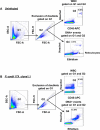
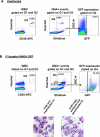
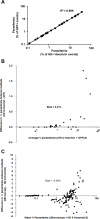
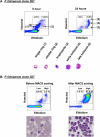
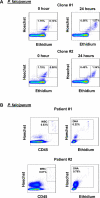
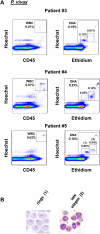
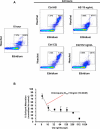
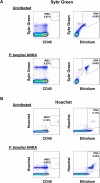
Similar articles
-
Cytofluorometric detection of rodent malaria parasites using red-excited fluorescent dyes.Cytometry A. 2011 Nov;79(11):965-72. doi: 10.1002/cyto.a.21119. Epub 2011 Aug 25. Cytometry A. 2011. PMID: 22015734 Free PMC article.
-
Characterising the effect of antimalarial drugs on the maturation and clearance of murine blood-stage Plasmodium parasites in vivo.Int J Parasitol. 2017 Dec;47(14):913-922. doi: 10.1016/j.ijpara.2017.05.009. Epub 2017 Aug 31. Int J Parasitol. 2017. PMID: 28864033
-
High-throughput multi-parameter flow-cytometric analysis from micro-quantities of plasmodium-infected blood.Int J Parasitol. 2011 Oct;41(12):1285-94. doi: 10.1016/j.ijpara.2011.07.010. Epub 2011 Aug 26. Int J Parasitol. 2011. PMID: 21907206
-
Recent advances in malaria research: parasite biology, chemotherapy and host/parasite relationships.Ann Ist Super Sanita. 1985;21(3):271-90. Ann Ist Super Sanita. 1985. PMID: 3914847 Review. No abstract available.
-
Methodology and application of flow cytometry for investigation of human malaria parasites.J Immunol Methods. 2011 Mar 31;367(1-2):1-16. doi: 10.1016/j.jim.2011.01.015. Epub 2011 Feb 4. J Immunol Methods. 2011. PMID: 21296083 Free PMC article. Review.
Cited by
-
Dissecting the Gene Expression, Localization, Membrane Topology, and Function of the Plasmodium falciparum STEVOR Protein Family.mBio. 2019 Jul 30;10(4):e01500-19. doi: 10.1128/mBio.01500-19. mBio. 2019. PMID: 31363031 Free PMC article.
-
Methodology to streamline flow cytometric-based detection of early stage Plasmodium parasitemia in mice.J Microbiol Methods. 2022 Apr;195:106439. doi: 10.1016/j.mimet.2022.106439. Epub 2022 Mar 4. J Microbiol Methods. 2022. PMID: 35248600 Free PMC article.
-
Invasion-inhibitory antibodies elicited by immunization with Plasmodium vivax apical membrane antigen-1 expressed in Pichia pastoris yeast.Infect Immun. 2014 Mar;82(3):1296-307. doi: 10.1128/IAI.01169-13. Epub 2013 Dec 30. Infect Immun. 2014. PMID: 24379279 Free PMC article.
-
Malaria abrogates O'nyong-nyong virus pathologies by restricting virus infection in nonimmune cells.Life Sci Alliance. 2022 Jan 17;5(4):e202101272. doi: 10.26508/lsa.202101272. Print 2022 Apr. Life Sci Alliance. 2022. PMID: 35039441 Free PMC article.
-
Methylene blue inhibits the asexual development of vivax malaria parasites from a region of increasing chloroquine resistance.J Antimicrob Chemother. 2015 Jan;70(1):124-9. doi: 10.1093/jac/dku326. Epub 2014 Aug 21. J Antimicrob Chemother. 2015. PMID: 25150147 Free PMC article.
References
-
- Laveran A. Note sur un nouveau parasite trouve dans le sang de plusieurs malades atteints de fievre palustre. Bull Acad Med 9, 1235–1236 (1880).
-
- Giemsa G. Eine Vereinfachung und Vervollkommnung meiner Methylenazur-Methylenblau-Eosin-Färbemethode zur Erzielung der Romanowsky-Nochtschen Chromatinfärbung. Centralblatt für Bakteriologie 37, 308–311 (1904).
-
- Myler P., Saul A., Mangan T. & Kidson C. An automated assay of merozoite invasion of erythrocytes using highly synchronized Plasmodium falciparum cultures. Aust J Exp Biol Med Sci 60, 83–89 (1982). - PubMed
Publication types
MeSH terms
Substances
Grants and funding
LinkOut - more resources
Full Text Sources
Other Literature Sources
Medical
Research Materials
Miscellaneous

